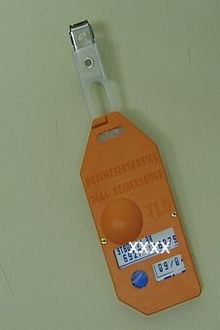
Back مقياس الجرعة الضيائية الحرارية Arabic Thermolumineszenzdosimeter German Dosímetro de termoluminiscencia Spanish دزیمتر تیالدی Persian 熱ルミネッセンス線量計 Japanese Dosímetro termoluminescente Portuguese Термолюминесцентный дозиметр Russian Termoluminiscentni dozimeter Slovenian வெப்ப ஒளிர்வு கதிர் ஏற்பளவுமானி Tamil

A thermoluminescent dosimeter, or TLD, is a type of radiation dosimeter, consisting of a piece of a thermoluminescent crystalline material inside a radiolucent package.
When a thermoluminescent crystal is exposed to ionizing radiation, it absorbs and traps some of the energy of the radiation in its crystal lattice. When heated, the crystal releases the trapped energy in the form of visible light, the intensity of which is proportional to the intensity of the ionizing radiation the crystal was exposed to. A specialized detector measures the intensity of the emitted light, and this measurement is used to calculate the dose of ionizing radiation the crystal was exposed to. Since the crystal density is similar to human soft tissue density, the dose measurement can be used to calculate absorbed dose.[1]
Materials exhibiting thermoluminescence in response to ionizing radiation include calcium fluoride, lithium fluoride, calcium sulfate, lithium borate, calcium borate, potassium bromide, and feldspar. It was invented in 1954 by Professor Farrington Daniels of the University of Wisconsin-Madison.[2]
- ^ Izewska, J; Rajan, G. Radiation Dosimeters (PDF). International Atomic Energy Agency. p. 88. Archived from the original (PDF) on 11 April 2021.
- ^ Radiation Dosimetry John Cameron. Environmental Health Perspectives Vol.91, pp. 45-48, 1991.